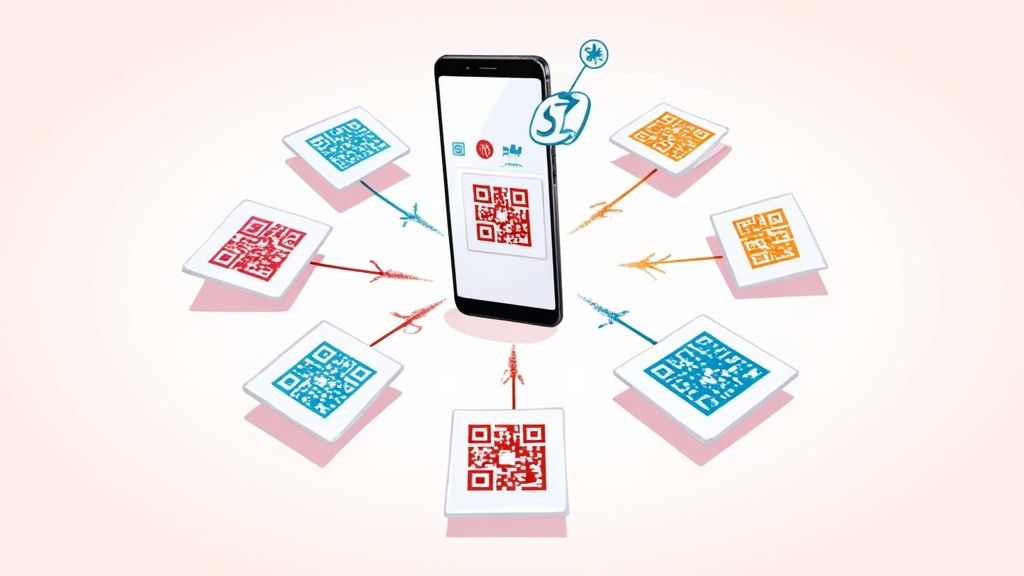Why Your QR Code With Logo Needs To Work Like Magic
Let’s be honest, a QR code with your logo should be a marketing dream. Instant info meets brand recognition—what’s not to love? But I’ve seen so many branded QR codes fall flat. Pixelated, unscannable…they’re a real turn-off. There’s a subtle psychology at play here. When someone spots your logo inside that code, they instantly decide: trust or ditch.
This isn’t just about looking good. A well-designed branded QR code can actually boost your scan rates by a whopping 300%. But a bad one just looks messy. I’ve seen tiny, strategically placed logos work wonders, while big, clunky ones completely bomb. It all comes down to balancing design and function. And speaking of function, QR code use in marketing has skyrocketed, up 323% according to recent stats (Discover more insights). Clearly, QR codes are a marketing powerhouse, and integrating your logo the right way supercharges their impact.
So, how do you create QR code magic? Let’s dive into the secrets.
The Secret Balance Between Beautiful And Scannable
Adding a logo to your QR code can really make it pop, but there’s a fine line between style and function. QR codes rely on something called error correction, meaning you can actually cover up about 30% of the code and it’ll still work. But placement is way more important than size. I’ve seen tiny logos tucked away perfectly that scan like a dream, while big, centered logos completely fail.
Why is that? It all comes down to how the logo placement messes with the code’s data modules. Think of it like a puzzle – some pieces are more important than others. A small logo nestled in a less critical area won’t affect readability, but a huge logo covering key data points? Useless. Also, intricate logos with sharp angles can cause more problems than simpler, rounded designs.
Even color plays a role. That fancy gradient in your logo might look awesome, but if it reduces contrast, it kills scannability. High contrast between the logo and the QR code is essential. This helps smartphone cameras easily pick up the pattern, no matter the lighting. Let’s look at some examples of where that sweet spot lies between a beautiful, branded QR code and one that’s just broken.

Making Your QR Code With Logo Impossible To Ignore
Your perfectly designed logo-embedded QR code is ready to go. Fantastic! But now comes the real test: will it actually get scanned? Trust me, placement is everything. A QR code that’s perfectly readable on a business card might be totally invisible on a billboard. Let’s talk about how size, color, and the surrounding design can make or break your QR code’s effectiveness.
One of the first things to think about is viewing distance. A QR code stuck on a product package needs to be significantly larger than one printed on a flyer someone’s holding in their hand. Makes sense, right? You also need to consider color contrast. Sure, you want your logo to stand out, but not if it makes the code itself hard to read. Aim for high contrast to ensure quick and easy scans, even in less-than-ideal lighting conditions.
Another key aspect is the psychology of scanning. People are naturally drawn to visually appealing designs. Think about it – a well-placed QR code with a clear call to action (something like “Scan for a 15% discount!“) is way more enticing than a lonely, uninspired square. Little things like clean lines and professional fonts also play a role in building trust. It all comes down to creating a seamless experience that makes scanning feel natural and intuitive.
Speaking of scanning, did you know QR code adoption has absolutely exploded? Over 26.95 million scans were recorded in more than 50 countries in 2022-2023, and that number is projected to grow by 22% by 2025! So, get your QR code strategy dialed in now, and be ready for the scanning surge!
Troubleshooting When Your Logo QR Code Won’t Scan

I’ve been there. You’ve crafted the perfect logo QR code, looking sleek and professional, only to find it stubbornly refuses to scan. It can be a real head-scratcher, trust me. Often, what looks like one problem is actually something else entirely. Size issues might actually be contrast problems, and placement problems could be down to something as simple as the file format.
Systematic Testing: Your First Line of Defense
The best approach here is a systematic one. Don’t just try one scanner in one place. Mimic real-world conditions. Test your QR code under different lighting, using various scanning apps on different phones. This will give you a much better understanding of what’s playing nice with your code and what isn’t. I’ve had codes work flawlessly in bright sunlight, then completely fail in a dimly lit restaurant. That’s a classic contrast issue.
Common Culprits and Quick Fixes
Logo Bleeding: This one’s a common trap. Make sure your logo isn’t creeping into the vital data modules of the QR code itself. Think of it like a delicate dance – you want the logo to be prominent, but it can’t step on the QR code’s toes. Tweaking the size and position is usually all it takes
Contrast Woes: If the contrast between your logo and the QR code is too low, scanners can have a hard time. A simple fix? Choose a high-contrast logo, or adjust the QR code’s colors. A little pop can make a big difference.
File Format Conflicts: Sometimes, the problem is the file format itself. Stick to SVG or PNG for your logo. They generally provide the best results. If you’re using QR Star, their reporting features can give you a deeper look at scan performance. This can be a real lifesaver for spotting trends and troubleshooting those pesky scanning issues.
Your Logo QR Code Success Blueprint
A QR code with a logo is a powerful branding tool, but only if it works seamlessly. I’ve seen enough QR code fails to know that a solid plan is essential. This blueprint is your guide to getting it right every time.
Let’s talk logo prep first. You want a clean, high-contrast logo in SVG or PNG format. This isn’t just for aesthetics – it’s crucial for scan reliability. Think of it like this: the scanner needs to easily “read” both the code and the logo. A cluttered logo or low contrast can confuse the scanner.
Next up, QR code generation. QR Star gives you good control over logo placement and size. Play around with our features, but remember: scannability is king. Don’t let your logo cover those important data modules!
Now, here’s where many people trip up: testing. Seriously, don’t skip this. Test your QR code with different phones, scanning apps, and lighting conditions. Think about where your code will be used. Is it going on a dimly lit poster or a brightly lit storefront? Mimic those real-world scenarios. If it scans consistently, you’re golden.
Finally, placement matters. A tiny QR code on a billboard? Not going to work. A massive one on a business card? Overkill. Consider the context and size accordingly. And always use a clear call to action. Tell people what to expect when they scan!
Ready to create a QR code that’s both beautiful and functional? Head over to QR Star and start designing!
